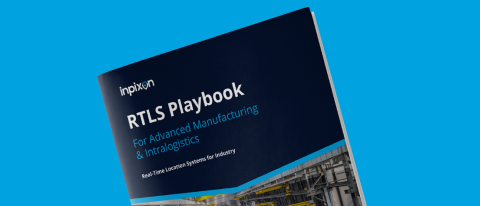For over 20 years, Chirp Spread Spectrum (CSS) has established itself as a reliable technology in the RTLS space. It’s known for its best-in-class mix of long ranging, high accuracy and superior reliability which has become useful for multiple use cases when using an RTLS. This article will explore exactly how Chirp Spread Spectrum (CSS) works and use cases to show how it’s made such a lasting impact in the industry.

What is Chirp and How Does it Work?
Chirp is a type of radio-frequency (RF) technology leveraged by Real-Time Location Systems (RTLS) for wireless communication. RTLS works by combining hardware and software to enable location tracking of various assets, from livestock and personnel to merchandise and vehicles. Organizations with an RTLS aim to gain greater visibility in their operations from the location data that is gained. Within a given space, tracking tags are attached to assets, and those tags communicate with fixed anchors in the area to transmit location information to the RTLS location engine and software.
Determining the location or position of an asset consists of two-way data communication between anchors and tags to configure and maintain communication for messaging, confirmations, evacuation or distress calls and more. Chirp uses two main techniques:
- Location Tracking: This method consists of determining the location of assets using Time Difference of Arrival (TDoA). With TDoA, the position of an asset is determined by timestamping the exact Time of Arrival (ToA) of a signal from tag to chirp anchors. The location engine then calculates the position based on the different times of arrival and multilateration.
- Ranging: Two Way Ranging (TWR) consists of determining the position of an asset using two-way communication between tags by their Time-of-Flight (ToF), with no anchors or infrastructure involved. The time it takes for signals (also called chirp pulses) to travel between the tags is multiplied by the speed of light to continuously determine their position.
How Does Chirp Compare to other Radio Frequency Technologies?
There are various forms of RF technologies used for RTLS like UWB, Wi-Fi and BLE, but chirp has its own set of unique advantages.
Chirp and UWB both use low power, have high reliability and great performance in asset tracking but have distinct features that make them suitable in different use cases. While UWB provides precise asset tracking with accuracy of 10-50 centimeters, chirp excels at providing long-range positioning of up to 1000 meters. In terms of frequency, chirp uses an ISM-band with 2.4 GHz, while UWB operates at a higher bandwidth from 3.1-10.6 GHz.
Bluetooth (BLE) is used in many of today’s wireless devices, and with RTLS it uses low power and has a low cost just like chirp. However, chirp delivers superior performance in terms of positional accuracy and protection against signal interference.
Wi-Fi is another widely used RF technology and is key for indoor location use cases. With Wi-Fi being popular in mobile technologies, it’s often used in situations where a high degree of accuracy isn’t needed. In advanced applications, chirp is a more reliable option in terms of accuracy, range, latency and cost.
RF Technology Comparison Chart
|
|
Accuracy |
Range |
Latency |
Protection Against Interference |
Frequencies |
Cost |
|
Chirp |
1-2 m* |
10-500 m* (up to 1000 m) |
< 1 ms to get location |
Strong |
ISM-band 2.4 GHz (2.4-2.4835) |
$ |
|
UWB |
+/- 40 cm* |
0-50 m (up to 200 m) |
< 1 ms to get location |
Strong |
3.1 – 10.6 GHz |
$$ |
|
BLE |
< 5 m* |
0-25 m* (up to 100 m) |
Typically 3-5 s to get location |
Weak |
2.4 GHz |
$$ |
|
Wi-Fi |
< 10 m* |
0-50 m* (up to 500 m) |
Typically 3-5 s to get location |
Weak |
2.4, 5 GHz |
$$$ ($ with Wi-Fi access points) |
*With optimal conditions and deployment.
5 Challenges Chirp Solves that Other RF Technologies Often Don’t
- Being Able to Work Both Indoors and Outdoors: Unlike other RF technologies, chirp can function in and outdoors - proving useful across large facilities, tracking vehicle routes to warehouses and getting the location of livestock.
- It Can Operate Over Long Ranges: Chirp has a longer range than most RF technologies, from 10-500 meters and up to 1000 meters. This allows real-time locationing in outdoor campuses, large warehouses, cattle farms and more.
- Protection Against RF Interference: Avoid radio frequency interference & signal propagation challenges with chirp; known for its high reliability as it operates on a lower frequency. It also uniquely leverages Carrier Sense Multiple Access (CSMA) supporting large scale deployments with tens of thousands of tags sending data.
- Helps Companies Stay On-Budget Due to its Lower Cost: Chirp’s long ranging makes communication between tags and anchors easier, resulting in fewer anchors required for deployments. For example, in a 2D space where UWB would require 6-10 anchors, chirp would require around 4-6. Because chirp requires less infrastructure than other RF technologies, it serves as a cost-effective option that often leads to higher returns.
- Meets Regulatory Compliance for the Outdoors: Since some RTLS technologies like UWB are often not allowed to be used outside, the Chirp 2.4GHz ISM Band is a great option to perform global installations without regulation constraints like a spectrum license.
Practical Applications for Chirp in Industrial Settings

Collision Avoidance & Worker Safety
There are numerous situations where accidents can happen at work- from a forklift collision in a warehouse or in industrial environments like underground mining. This is why many organizations invest in RTLS, to keep their employees safe by tracking the real-time location of personnel and assets. When machines, vehicles and employees all have tags, they can easily be identified on a digitized map, allowing for optimized worker search and rescue, employee mustering and evacuation scenarios. The geofencing feature of an RTLS can also be used to create safety zones that work with traffic management systems, to prevent work collisions.
RTLS leverages collision avoidance systems (CAS) for vehicle-to-vehicle and vehicle-to-people scenarios by using proximity detection and alerts to automate incident identification. TWR is especially useful for collision avoidance, since communication between tags is faster than sending information to a server before an alert can be created. Remote control CAS is another use case, suitable for preventing employees from accidentally running themselves over with heavy machines or equipment (such as cranes and excavators).
Livestock and Other Outdoor Tracking
Since Chirp’s range can be extended into both indoor and outdoor areas, it can be used for livestock tracking and other outdoor scenarios. Chirp gives organizations the ability to get the location of livestock in near real-time, and track the wellbeing of animals using the data being generated from the RTLS. Location data can help detect early signs of illness, from data points such as temperature and movement, tracked by tags.
In and outdoor tracking is also useful in manufacturing and warehousing, by closing the gap between asset tracking from an outdoor vehicle to a warehouse, or tracking the location of pallets from stock as they move into their next destination by truck. This allows full visibility in the warehouse, and the location data can be used to create optimized routes for merchandise and vehicles.
Proactivity in Harsh Environments
With many RF technologies, destructive interferences can cause a disconnect in the communication link, affecting the accuracy of an RTLS. In underground coal mines or open pit mining, materials such as ground salt and precious metals can get in the way. However, chirp is highly resistant to RF interference, which is why it’s suitable in harsh industrial environments where reliability and proactivity are of utmost importance.
Have UWB but Interested in Chirp?
While chirp and UWB both have their own set of benefits, organizations may opt to invest in both, to benefit from their complementary effects. Inpixon offers the unique ability to combine chirp and UWB in RTLS deployments, enabling a wide range of solutions and allowing businesses to benefit from the advantages of both RF technologies. For example, in the case of a fire, an organization can opt to find the rough direction and position of outdoor firefighters using chirp since UWB may not even reach the search target. To then get the precise location within meters of a person, narrow in using UWB. This combines outdoor capability, long ranging, centimeter accuracy and high reliability all in one.
A Recap - The Benefits of Combining Chirp and UWB
- Keep track of the location of assets from long ranges using chirp, and to their most precise position using UWB. For example, finding tagged firefighters.
- Different zones may have varying accuracy and range requirements. Use chirp for general use cases such as the waiting room of a hospital where meter accuracy is good enough, and UWB for precise applications, such as in a surgery room to track if the patient is on the operating table.
- If a tag goes out of range due to attenuation or RF interference, it can switch to chirp from UWB.
- Since UWB is restricted for outdoor use, switch to chirp to track security guards, vehicles and more.
- UWB delivers accuracy for fine & granular collision avoidance use cases. Chirp adds higher ranges, more reliability and complements the high accuracy of UWB.
Get Started with Chirp
From collision awareness to tracking manufactured cars, chirp’s benefits and use cases make it a standout among other RF technologies. Interested in learning more about how chirp can help your organization meet its operational and revenue goals? Contact us today.



-3.png?length=1000&name=Inpixon%20LinkedIn%20Banner%20August%202025%20(2)-3.png)

